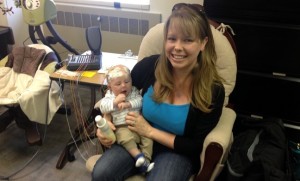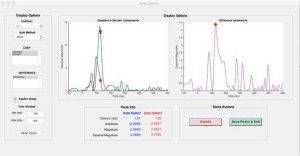

Universal newborn hearing screenings have resulted in earlier access to auditory information through hearing device fittings and intervention services for children with hearing loss. Despite such significant gains, these children continue to exhibit delayed spoken language compared to their hearing peers. Research with hearing infants has demonstrated that early exposure to speech is critical to spoken language development. Infants with hearing loss are likely to experience spoken language delays in the first year of life if hearing aids do not provide full access to spoken language.
Unfortunately, recent research indicates that a majority of hearing aid fittings for children with hearing loss do not provide complete access to the auditory speech spectrum. This contributes to speech and language delays. These delays show up in spoken language abilities and may explain later challenges with literacy. In addition, the usual protocols to assess hearing aid fittings cannot be used with infants younger than 2.5 years of age. This makes fitting hearing aids at an early age very challenging. Further, the ways in which infants older than 6 months respond to stimuli are variable, which further complicates clinical judgment of whether hearing aid fittings are appropriate.
Project Focus
In this project, we aim to develop a set of tools that will help clinicians improve the assessment and intervention of hearing aid fitting in infants and toddlers. To achieve this aim, we are studying the relationship between physiological and behavioral measures of speech sound discrimination. Physiological measures provide objective information about how the brain is responding to different sounds. We record the brain activity of infants under 3 months old in an EEG, while they listen to speech sounds. An automated procedure detects and classifies the infants’ speech discrimination responses from the EEG. Behavioral measures are then applied for the same speech sounds after the infants are older than 6 months. A procedure called visual reinforcement infant speech discrimination (VRISD) allows us to test whether a toddler will respond to a change in speech sounds. The combination of EEG and VRISD responses will allow us to develop a set of testing protocols that clinicians can use to cross-validate the hearing aid fitting.
After being adequately fit with hearing aids, it is imperative that the child has regular access to spoken language to facilitate typical spoken language learning. We are collaborating with the LENA Research Foundation to test a mobile device that allows us to assess the amount of spoken language to which a child is exposed during a typical day. The device provides a comprehensive language report for both clinicians and parents using technologies such as smart phones and tablets. This information can then be used to study how hearing aids and daily language exposure each contribute to the development of spoken language skills. Further, the information obtained from this study will allow us to fine-tune the protocols for both EEG and VRISD testing. Taken together, these studies will allow us to develop a comprehensive set of tools to optimize access to spoken language in infants and toddlers with hearing loss.
Project Team
This project is led by the University of Colorado-Boulder and collaborates with the local Hands and Voices chapter, a parent organization. Team members include:
- Phillip Gilley, PhD (Investigator), Research Associate, University of Colorado-Boulder, Institute of Cognitive Science
- Christine Yoshinaga-Itano, PhD (Investigator), Professor, Speech, Language and Hearing Sciences, University of Colorado-Boulder
- Zoe Boxer (Student Research Assistant), Au.D. Candidate, University of Colorado-Boulder
